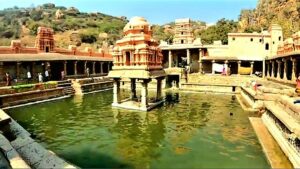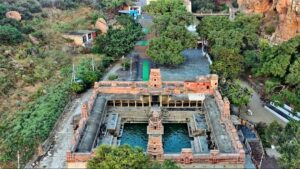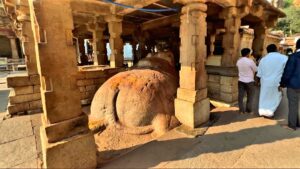Yaganti Temple: A Journey Through Mystique and Divinity

Yaganti Temple, also known as Sri Yaganti Uma Maheshwara Temple, is a revered ancient shrine dedicated to Lord Shiva, nestled amidst the picturesque hills of Nandyal district, Andhra Pradesh. This magnificent temple not only holds immense religious significance but also attracts thousands of devotees and tourists each year, making it a must-visit destination for anyone seeking peace, history, and divine blessings.
A Historical Marvel

Built during the 15th and 16th centuries by the rulers of the Vijayanagara Empire, Yaganti Temple is renowned for its stunning architecture and unique legends. As visitors approach, the temple structure appears square-shaped from the front, welcoming them with its grandeur. After climbing a series of stairs, one is greeted by the majestic entrance, leading to one of the temple’s most fascinating features—the Pushkarini Pond. This sacred pond holds an important place in the temple’s history and mysticism, believed to have healing properties.
7 Enigmatic Secrets of Yaganti Temple
The temple is steeped in legends, each adding to its mystical aura. Here are seven enigmatic secrets associated with Yaganti Temple that continue to intrigue visitors:
1.The Ever-Growing Nandi Idol: The idol of Nandi, the sacred bull and vehicle of Lord Shiva, is said to be ever-growing. Locals believe it has increased in size over the years, a phenomenon that baffles visitors and devotees alike.
2.The Mysterious Pushkarini Pond: The Pushkarini Pond within the temple complex is renowned for its fresh water that flows continuously from an unknown source. Devotees believe that bathing in this pond has healing properties.
3.Agastya Rishi’s Penitence: Legend has it that the sage Agastya performed severe penance in this region. His presence and the caves associated with him add to the temple’s mystical aura.
4.The Cursed Crow: A story tells of a crow that disturbed Agastya during his meditation. Angered by its antics, Agastya cursed the crow, resulting in a belief that no crows can be seen near the temple today.
5.Three Mysterious Caves: The temple complex houses three caves—Agastya Rishi Cave, Venkateshwara Cave, and Brahma Cave—each with its own legends and idols, believed to have divine significance.
6.The Whispering Stones: It is said that certain stones around the temple can whisper the secrets of the universe to those who are spiritually attuned, offering profound insights to visitors.
7.Connection to Kailash: The temple is believed to resemble Mount Kailash, the abode of Lord Shiva, and has become a pilgrimage site for those seeking spiritual enlightenment, drawing comparisons to the sacred mountain.
How to Reach Yaganti Temple

Yaganti Temple is easily accessible, located approximately 100 km from Kurnool in the Nandyal district of Andhra Pradesh.
•By Road: The most convenient way to reach Yaganti is by road. Regular buses operate from nearby cities like Kurnool, Nandyal, and Hyderabad. A bus stand near the temple offers buses, taxis, and autos for a comfortable journey.
•By Rail: The nearest railway station is at Nandyal, located around 55 km away. From Nandyal, you can hire a taxi or take a local bus to reach the temple.
•By Air: The nearest airport is Kurnool Airport, about 100 km from the temple. You can take a taxi or bus from the airport to reach Yaganti.
The scenic route to Yaganti offers beautiful views of the surrounding hills, adding to the spiritual and peaceful atmosphere of the journey.
The Mystical Pushkarini Pond

The Pushkarini Pond is unique due to its mysterious source of water, continuously fed by fresh and sweet water flowing from the surrounding hills. The water reaches the pond through a spout called Gomukh, directly filling it. Locals believe that this water is holy and has healing properties. Bathing in the pond is said to relieve various diseases, and many devotees cleanse themselves in its waters before entering the temple to worship Lord Shiva.
History and Legend of Yaganti Temple

Originally intended as a temple dedicated to Lord Vishnu, Yaganti Temple’s history is rich with legend. Sage Agastya selected this site for a Vishnu temple and even commissioned an idol of Lord Vishnu. However, during installation, the idol’s wing broke. Enraged, Sage Agastya abandoned his plan and began worshiping Lord Shiva instead. It is believed that Lord Shiva appeared before him and advised that the location was more suitable for a Shivalaya (Shiva temple), as it resembled the holy Mount Kailash. Consequently, a Shiva Linga was installed, transforming the temple into a sacred shrine dedicated to Lord Shiva.
Devotional Significance

The temple is always abuzz with devotees, especially on Mondays, during the festival of Maha Shivratri, or in the auspicious month of Sawan. The sanctum, known as the Garbha Graha, houses the sacred Shiva Linga installed by Sage Agastya. Just outside the Garbha Graha, there is an idol of Shri Lakshmi Narayana, which also attracts many worshippers.
The Growing Nandi Idol


One of the most intriguing features of Yaganti Temple is the idol of Nandi Maharaj, Lord Shiva’s sacred vehicle. Devotees believe that the Nandi idol is continuously growing in size. According to local legend, the stone from which the Nandi idol is carved has a natural “growing” property. Over the years, the idol has increased in size, leading to speculations that by the end of Kaliyug, the idol will come to life and roar.
The Caves of Yaganti
Yaganti Temple is also famous for its three sacred caves, each with a unique history:

1.Agastya Cave: Situated at a high altitude, this cave is named after Sage Agastya, who performed penance here. Inside the cave is an idol of Goddess Durga, worshiped by devotees. To reach the cave, one must climb about 120 stairs.

2.Venkateswara Cave: In this cave, an idol of Lord Venkateswara, a form of Vishnu, is installed. Interestingly, the idol here resembles the one found in Tirupati Balaji Temple. This cave is easier to access, requiring a climb of about 80-90 steps.

3.Brahma Cave: It is said that Lord Brahma himself appeared in this cave, and his footprints are preserved here. The cave also contains a tunnel that stretches over 100 kilometers, although access to it is restricted.
Conclusion
The Sri Yaganti Uma Maheshwara Temple is a place of deep spiritual significance and ancient mysteries. From its origin as a Vishnu temple to its transformation into a sacred Shiva temple, Yaganti’s history is filled with fascinating legends. The mystical Pushkarini Pond, the ever-growing Nandi idol, and the holy caves all add to the temple’s allure. Visiting Yaganti Temple is not just a religious experience; it is a journey into the heart of Indian mythology and devotion.


1 thought on “7 Hidden Wonders of Yaganti Temple: Best History and Myth”